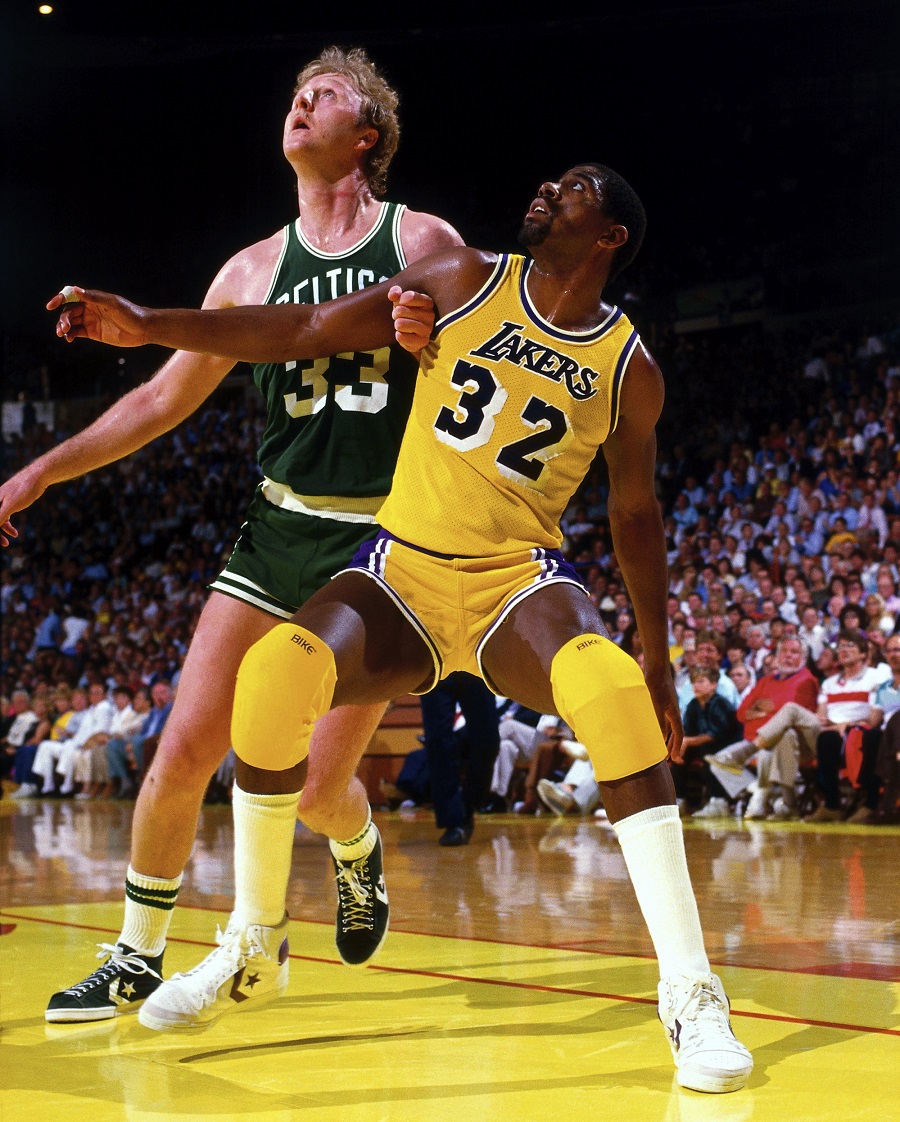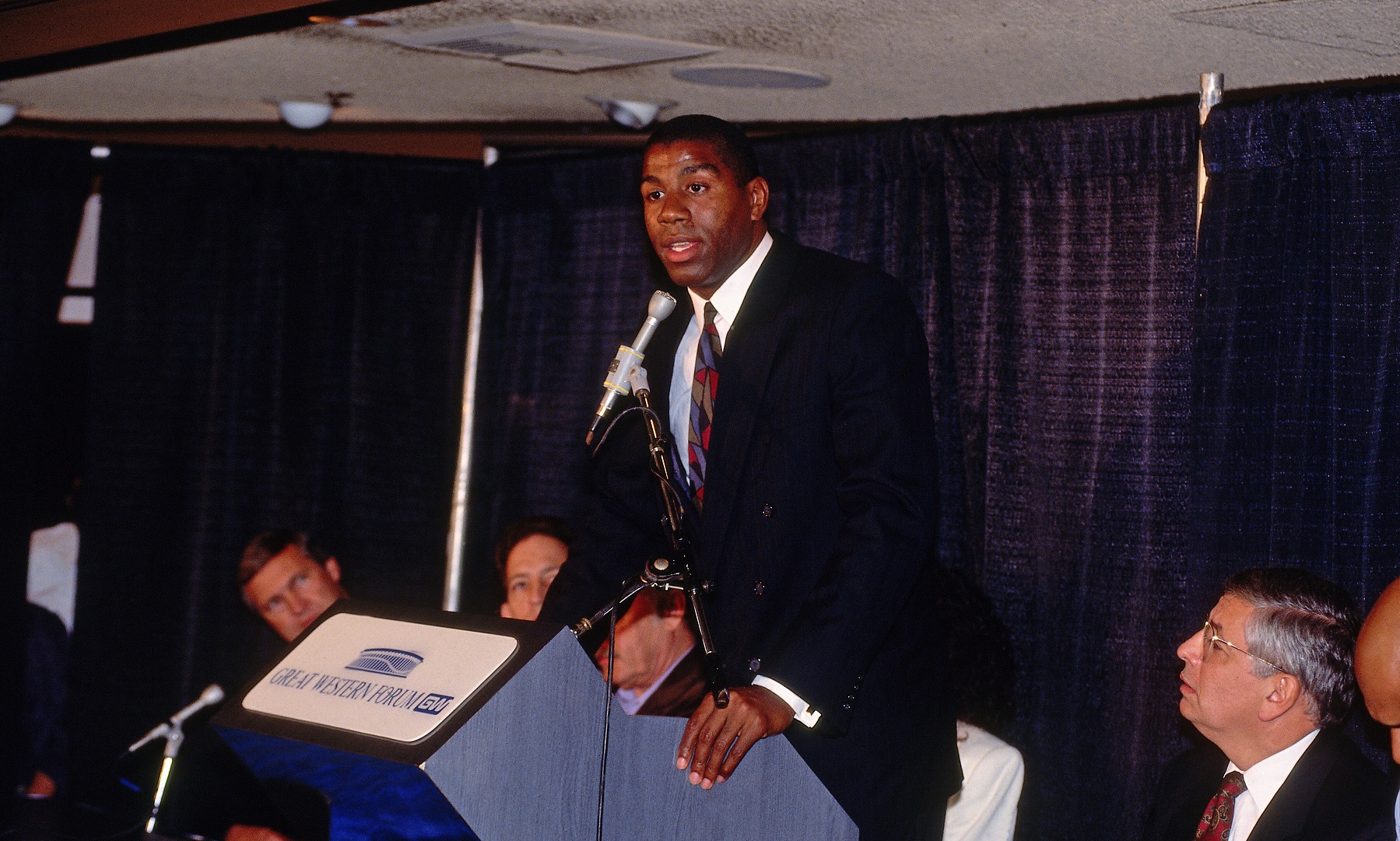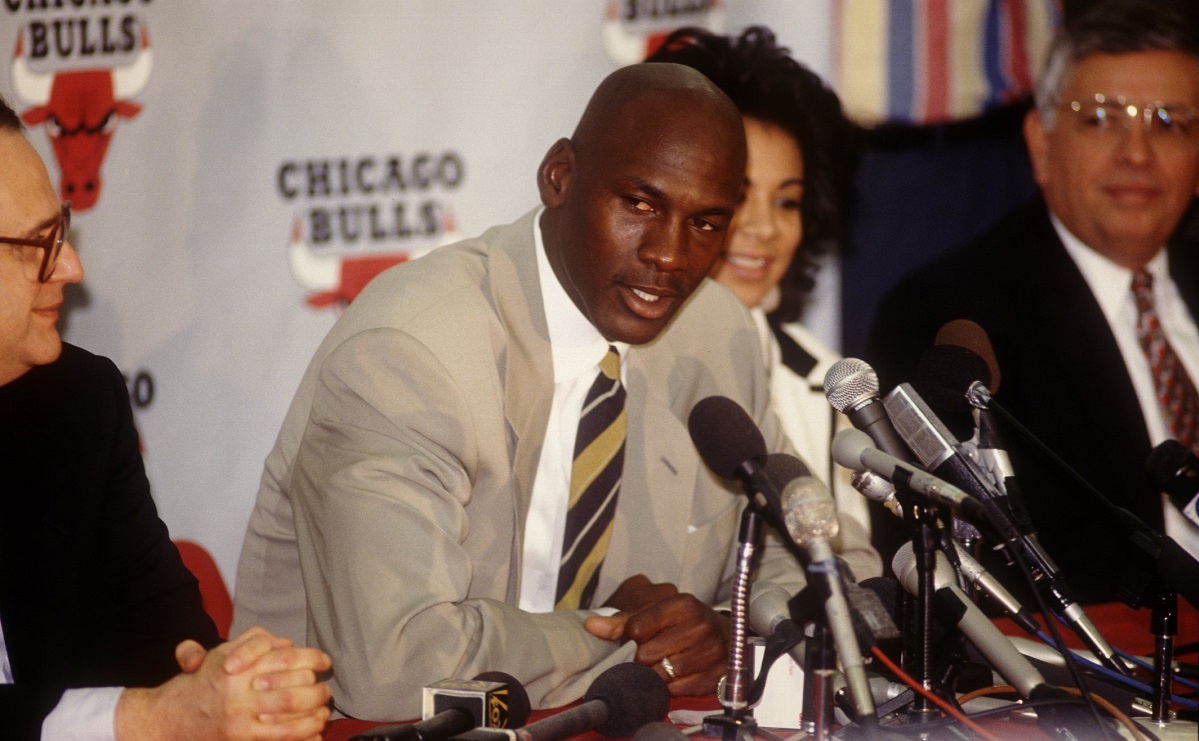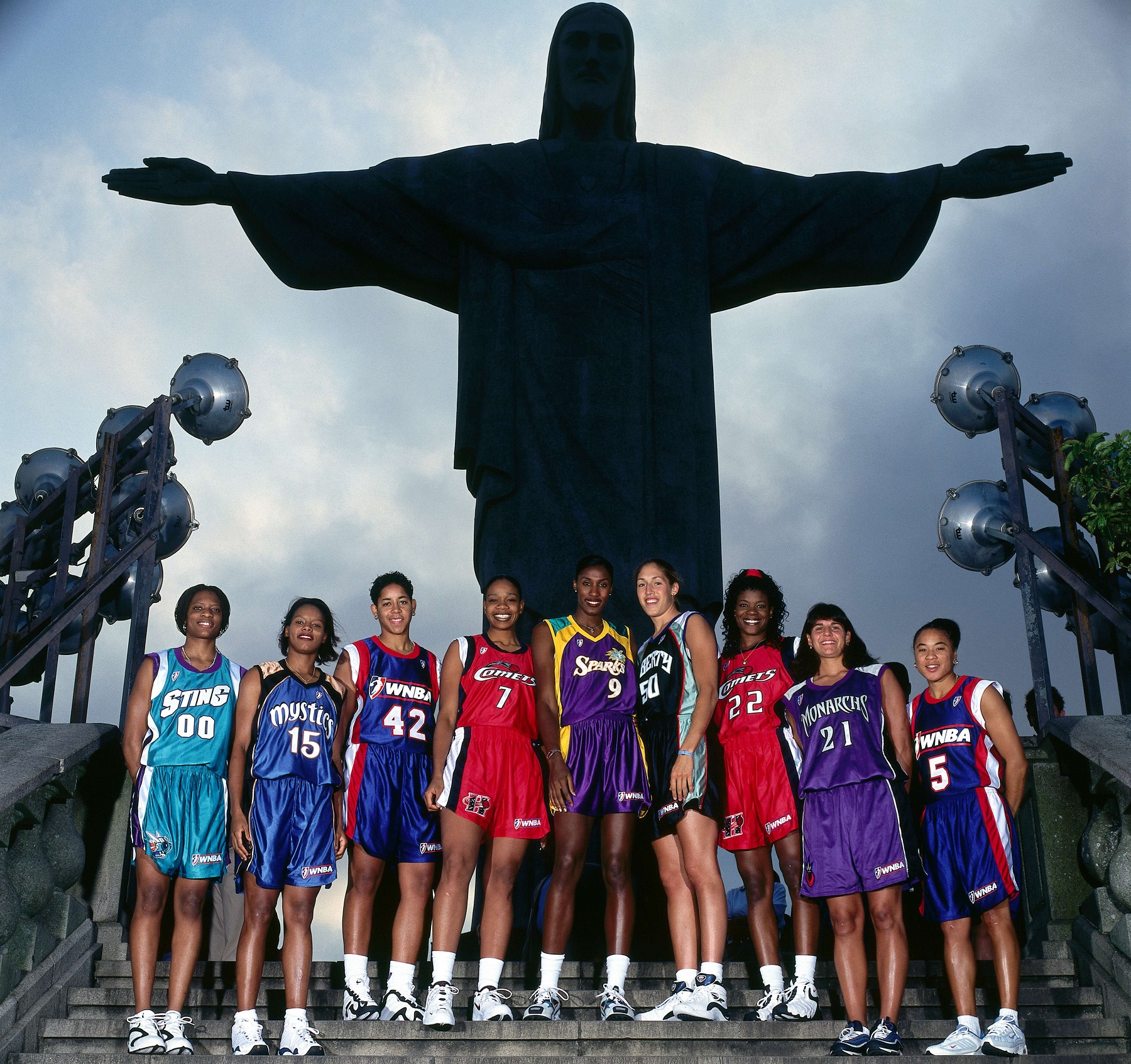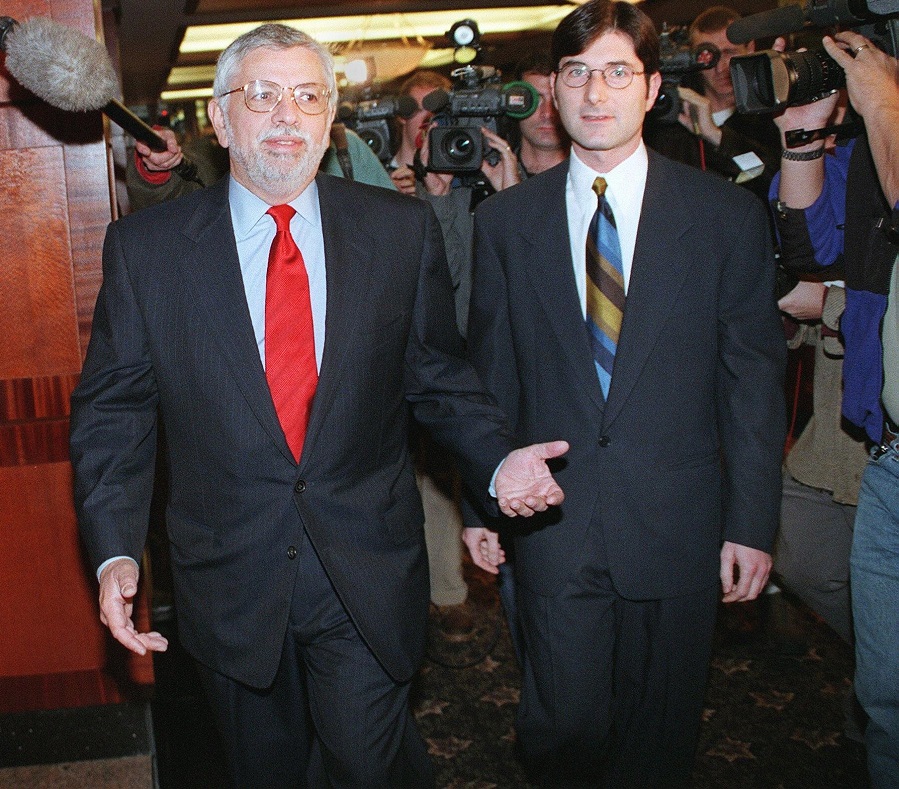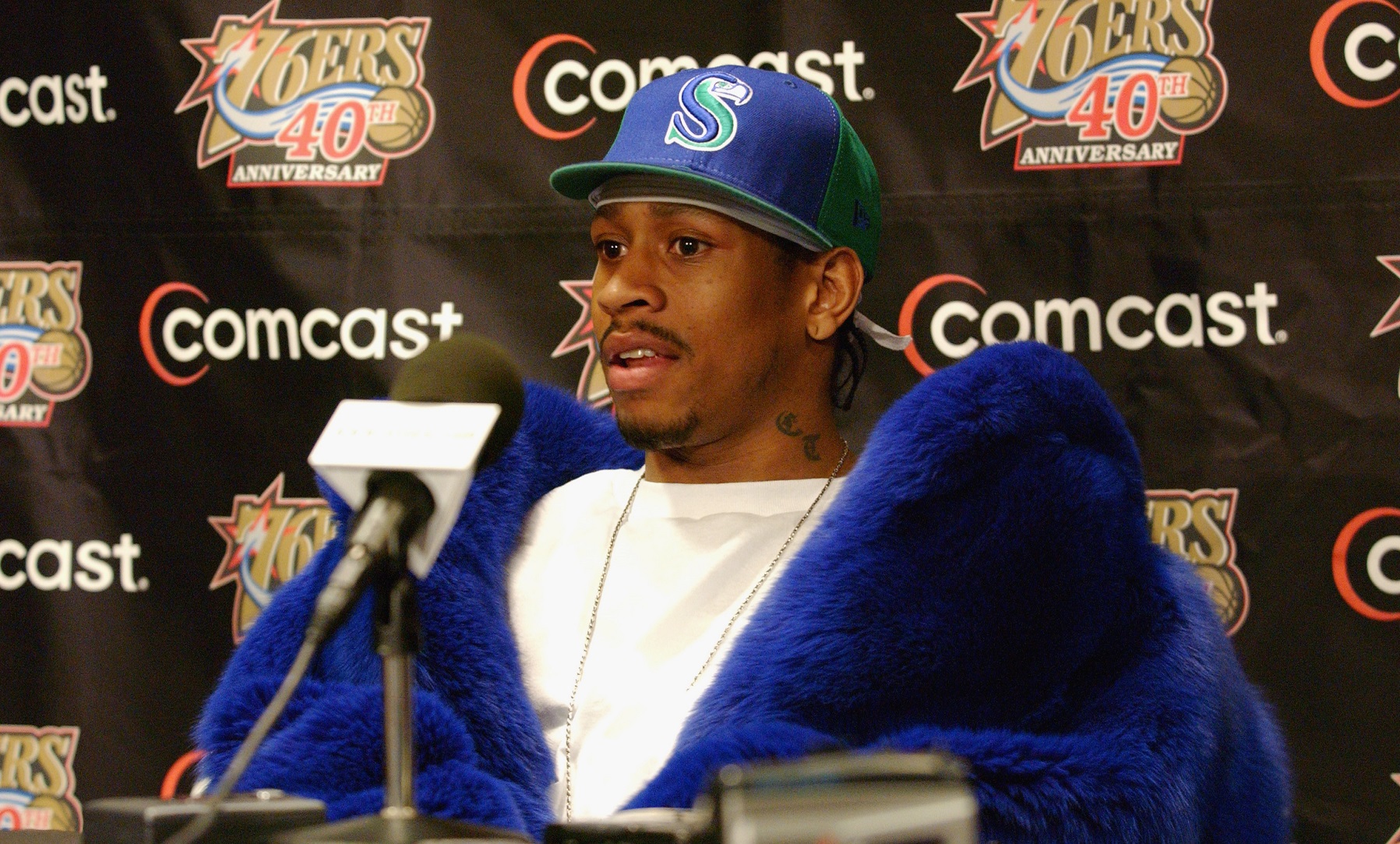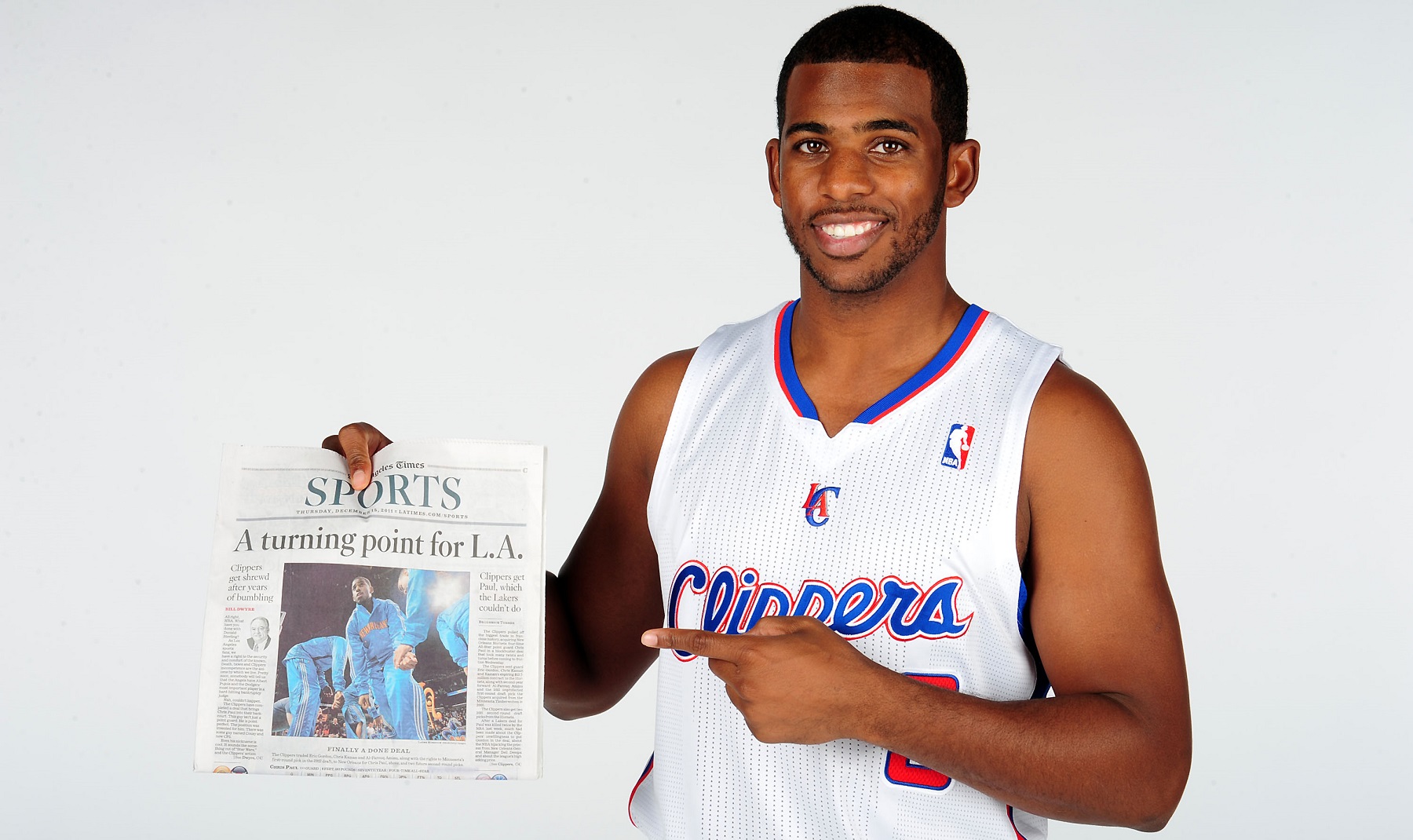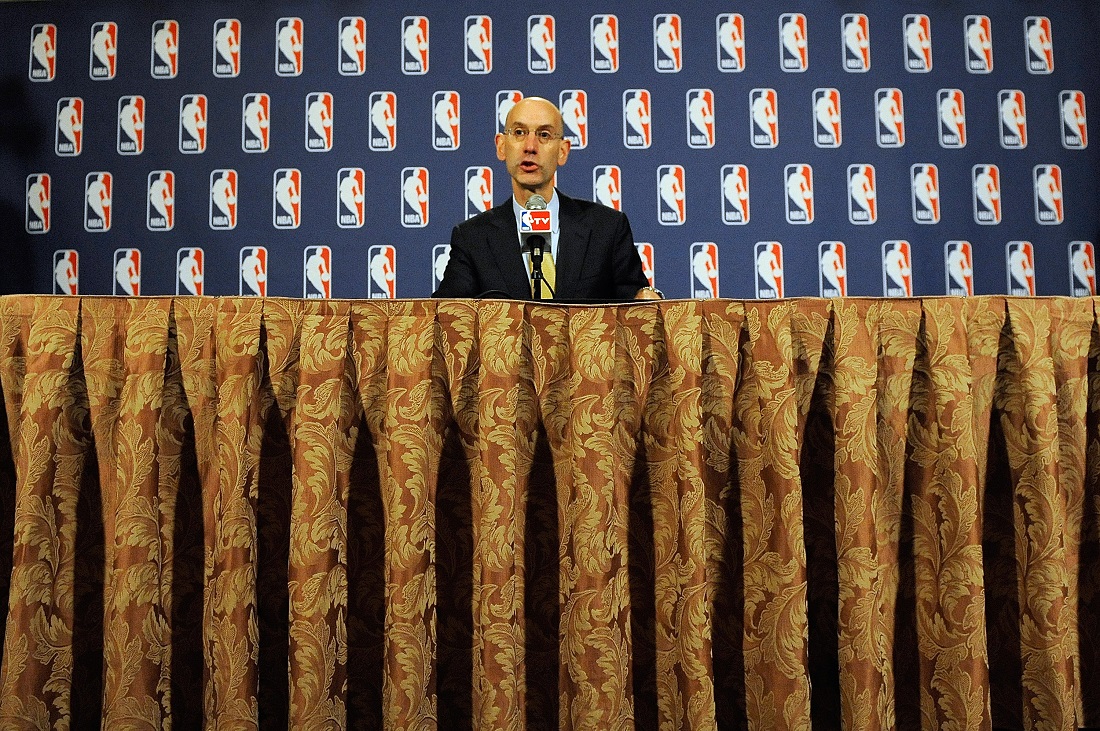
David Stern retrospectiveThe 30 biggest moments from the Commissioner's 30 years on the job
by Tom ZillerOn February 1, David Stern will retire as NBA commissioner after exactly 30 years on the job. His tenure almost defies summary, but we gave it a shot by looking at 30 seminal moments for Stern and the NBA over those three decades. Good moments, bad moments -- all of it. Everyone has an opinion on the job Stern has done, but it's worth considering the whole picture as we move on to the NBA's next era.
Magic vs. Bird (May-June 1984)
Stern took office on February 1, 1984. Four months later, the NBA's dream matchup -- Celtics vs. Lakers in the Finals -- came true. It'd be the first postseason meeting between Magic Johnson and Larry Bird since their epic 1979 NCAA Championship Game due and the first of three Finals meetings between the superstars. Each had won NBA titles by 1984, but these Finals rekindled the league's best rivalry -- the teams had met in the Finals six times in the '60s -- and cemented Stern's push for a league built on its stars. It also happened to be an excellent series, going the full seven games, capped by the performance of Cedric Maxwell's life in the finale. The timing of the matchup was a happy accident, but its impact would shape Stern's tenure.
Creation of the salary cap (1984)
It's tough to be an NBA fan these days without knowing all about the salary cap. Understanding the intricacies of the cap is now a full-time job with many teams. Back in 1984, things were way more simple. Ahead of Stern's first full season as commissioner, the NBA instituted a maximum team salary of $3.6 million, but this was not a hard cap. It allowed a handful of exceptions that allowed teams to keep their cores together and improve even if they were against the cap limit. One of those was the so-called Larry Bird exception, which allowed teams to go over the cap to retain their own free agents. Why is it named after Bird? The Celtics were the first to use it. The 1984 salary cap didn't put a max on individual salaries, though; that would come 15 years later. (By the way, the salary cap for the 2013-14 season is $58.6 million.)
The "frozen envelope" draft lottery (May 12, 1985)
Ahead of the highly-anticipated 1985 NBA Draft and in the wake of a 1983-84 season in which the Rockets seemed to intentionally lose in a bid to land the top pick, the league became concerned about teams tanking to boost their chances at picking Patrick Ewing, the dominant Georgetown center. To combat this, the league instituted a lottery system, which would give the seven worst teams a shot at the No. 1 pick.In a highly produced, televised event, Stern picked the New York Knicks' envelope from the hopper. Given Stern's New York roots and the league's perceived need to have a strong team in the country's media capital, the conspiracy theories sprouted immediately. In fact, Stern was asked about them at the lottery. "If people want to say that (the lottery was fixed), fine, as long as they spell our name right. That means they're interested in us. That's terrific."
The leading theory is that the NBA stuck the Knicks' envelope in a freezer before the lottery so that Stern would be able to locate it easily and pluck it out. The NBA has plenty more conspiracy theories, but this is the king of them. Stern's response didn't exactly do much to quell accusations, which live on to the modern YouTube era with the lottery's very own Zapruder film.
Micheal Ray Richardson banned (February 25, 1986)
One of the expressed rationales for the draft lottery was to help distract the media from the NBA's troubling drug problems. Cocaine use was said to be rampant in the league, as was alcohol abuse. During the 1985-86 season, Stern made a strong statement about the league's position on the cocaine epidemic by banning Richardson, an All-Star, for life after a third failed drug test. The league was criticized for its failure to help players battling addiction and for waiting so long to crack down. It wouldn't be the last time the NBA dealt with hard drugs -- No. 2 pick Len Bias died of a cocaine overdose months later, the Suns were torn apart by a drug scandal in the late 1980s, and Stern banned Chris "Birdman" Andersen in the 2000s -- but it was seen as a major statement by the Commissioner. The league later added marijuana to its banned substance list after a spate of player arrests and citations.
Major franchise expansion (April 22, 1987)
With Magic, Bird and Michael Jordan bringing the league to unprecedented heights of popularity, Stern looked to push into new markets, and in early 1987 awarded four expansion franchises. Notably, three -- the Heat, Hornets and Magic -- were awarded to the Southeast while the fourth, the Timberwolves, brought the NBA back to Minnesota, which had lost the Lakers decades prior. The expansion took the league to 27 teams. The Heat have won three titles and the Magic have made three Finals series, but the Wolves and Hornets (now Pelicans) have seen only limited success.
TNT begins airing NBA games (1988)
Stern had struck a deal with Turner Broadcasting soon after becoming commissioner, but TNT became the network most closely associated with the NBA in 1988, when it began airing multiple games per week. That deal lives on to this day, with TNT boasting a Emmy-winning studio show Inside the NBA in addition to a rotating cast of big-name play-by-play announcers (including Marv Albert) and analysts. TNT currently has the rights to the All-Star Weekend main events and shares the playoffs with ESPN/ABC. With a new TV deal being one of Adam Silver's first tasks as commissioner, we'll see whether the league's long relationship with Turner will carry on without Stern.
Magic's HIV announcement (November 7, 1991)
Perhaps no moment in NBA history was more powerful than when Magic Johnson, the beloved Lakers star, announced that he had contracted HIV and would retire from basketball. Stern stood beside Magic during the announcement. Magic's announcement did as much for widespread awareness and education about the virus as any outreach campaign could have. Over the objection of a few players, Stern cleared Magic to play in the 1992 All-Star Game after fans voted him in, and Magic won the MVP. It was a bold stand at the time and history reflects well on the NBA's handling of the issue.
The Dream Team (Summer 1992)
Stern and the NBA never really wanted to assemble the Dream Team: USA Basketball actually voted against allowing NBA players in the Olympics. But the rest of the world desperately wanted the best players to participate, so the NBA obliged. In 1992, Stern worked with USA Basketball leadership to turn the squad -- which had won bronze in 1988 -- into an NBA All-Star Team.
The rest is history. The Dream Team won the hearts and minds of the world (and every game they played). Michael Jordan was the headliner, but Scottie Pippen announced himself as a major star with his lockdown defense and Charles Barkley was never more controversial, or captivating. Even Christian Laettner scored a gold medal.
There's a whole generation of European, Asian, South American and African NBA players who cite 1992 as a formative basketball experience, and it remains a team American fans will never forget. Since then, owners have agitated against international play for veteran players; at some point, the NBA may restrict the Olympics or World Cup to young players only.
Jordan's first retirement (October 6, 1993)
Michael Jordan's announcement that he would retire at age 30 after winning his third straight championship was a stunner and a huge blow to Stern's star-focused NBA. The conspiracy-minded pointed to reports of MJ's proclivity for gambling and surmised that the retirement was actually a secret ban by Stern. No evidence has ever supported that theory. With the Bulls failing to make the Finals in 1993-94 without MJ, the league saw ratings for the championship series fall dramatically. Jordan played minor league baseball in the White Sox organization, then returned to basketball toward the end of the 1994-95 season. He'd win three more titles and define the decade in basketball. If he was banned by Stern, the commissioner backtracked pretty quickly once he saw how tough life after MJ would be.
Derek Harper vs. Jo Jo English (May 13, 1994)
Like so many impactful moments of Stern's tenure, the commissioner had a front row view for this one. In Game 3 of the '94 East semifinals, the Knicks' Derek Harper and the Bulls' Jo Jo English sparked a bench-clearing brawl literally right in front of Stern. (The NBC broadcast had a memorable shot of Stern standing, looking down in horror at the maelstrom just yards away.) The brawl directly led to a new rule: any player who leaves the bench and steps onto the court during a fight will be suspended one game. The rule's most famous applications possibly cost the New York Knicks and Phoenix Suns title shots in 1997 and 2007, respectively. Four Knicks were suspended for leaving the bench in Game 5 of the Eastern semifinals against the Heat in '97. What's worse is that the suspensions were staggered over two games, leaving New York below full strength for the remainder of the series, which Miami won 4-3. The rule struck again a decade later when in Game 4 of the '07 West semifinals Amar'e Stoudemire and Boris Diaw left the bench briefly after Robert Horry hip-checked Steve Nash into the scorer's table. Stoudemire and Diaw were suspended for the crucial Game 5, which San Antonio won, leading the Suns to fall to the Spurs in six in what was considered the de facto Finals. (San Antonio went on to win the title.)
Rookie scale instituted (September 12, 1995)
The NBA almost had its first impactful lockout in 1995. In fact, the owners did officially lock out players on July 1, but the union reached a deal with owners on by mid-September, saving the preseason in addition to all 82 regular season games. The major piece of the deal was the institution of the rookie scale. In 1994, top pick Glenn Robinson held out demanding a 13-year, $100 million contract from the Bucks. He ended up settling for $68 million over 10 years. Veteran players were largely receptive to restricting rookie salaries in order to free up more money for themselves. But in reality, this was the first step in the NBA's march toward scaling down the biggest salaries in the sport.
International teams debut (November 3, 1995)
The NBA joined Major League Baseball and the NHL in becoming an international league in 1995 with the debuts of the Vancouver Grizzlies and Toronto Raptors. Much like the four new teams established in 1989, the squads struggled. Toronto has been a lottery fixture over 18 years, and the Grizzlies lasted just six years in Canada before moving to Memphis. The Raptors have been a financial success, however, and Toronto boasts a vibrant fanbase despite the foibles of its team.
Creation of the WNBA (April 24, 1996)
NBA owners approved the creation of an 8-team women's league in 1996; it launched a year later. It's certainly had its share of growing pains, including massive franchise turnover. But over the years, strong markets sprung up in Connecticut, Minnesota, Seattle, L.A., Phoenix and elsewhere, and the league is stable at 12 teams. Notably, complaints about the cost of running the league were largely absent from the financial bickering that drove the 2011 NBA lockout. While pro women's basketball certainly hasn't become a major sport in the United States, there is now a reliable, viable women's league, which is something Stern can rightly point to as a positive mark on his progressive leadership.
1998 Lockout (July 1, 1998)
The 1998 lockout is also something Stern might be proud of for wholly different reasons. It was the first real strike against escalating payrolls, and it had a massive impact on the paychecks of stars and role players while making franchises much more valuable. The big-ticket items were the caps on player salary, contract length and annual raises. Kevin Garnett is often blamed for the shift -- he signed a 6-year, $126 million extension with the Timberwolves just months before the lockout -- but it wasn't only about Garnett. Stern and his owners were clearly on a path to limiting player salaries any way possible. Stern got the player maximum approved by appealing to mid-rung NBA players, of which there are vastly more in the union. But the negotiations cost the league 32 games and All-Star Weekend, and resulted in one of the worst seasons in memory.
Creation of the D-League (2001)
The NBA D-League began in 2001 with eight teams (all in the southeast) and about 120 players who couldn't quite get an NBA deal. The league expanded and shuffled fairly quickly, and in 2006 the Lakers became the first NBA team to buy their own D-League squad, hoping to turn it into a more traditional farm league team. Over the course of the next seven years, more and more NBA teams purchased D-League squads or entered single-affiliation agreements in which the NBA team runs basketball operations without owning the venture. Today, there are 17 D-League teams, from Boise to Santa Cruz and Maine to Delaware. Fourteen of those teams are affiliated with a single NBA team, and picks as high as No. 2 overall have been assigned to the league for work.
Yao joins the NBA (June 2002)
The story of how Yao Ming came to the NBA could fill a book. (In fact, it has filled several books. The best of the bunch is Brook Larmer's Operation Yao Ming.) Yao, a prodigally tall, smart and skilled player, became not just a perennial All-Star (usually deserving) and a powerhouse for some good Rockets teams, he was also the spark that opened up China to the NBA. The league remains popular years after Yao retired. Yao opened the doors to China for American stars like Kobe Bryant, Dwyane Wade and LeBron James. While there hasn't been an influx of Chinese players in the NBA -- Yi Jianlian washed out, and Jeremy Lin is both actually Taiwanese and has spent his entire life in the United States -- one assumes that at some point a generation inspired by Yao will make an impact in the league. Stern played a heavy role in negotiating with Chinese officials to get Yao's release, a task made more difficult by defection accusations against fellow Chinese big man Wang Zhizhi. Yao's NBA genesis is not just a fascinating story but one of the most impactful to the global future of the NBA.
The Hornets relocate (May 2002)
Stern's recommendation that the Board of Governors approve relocation of the Charlotte Hornets in 2002 set a pretty horrible precedent in the brewing battle between cities and franchise owners. Hornets owner George Shinn was accused of sexually assaulting a Charlotte woman in the late 1990s, and his image was tarnished locally. Then, he started demanding a new arena. After a failed referendum for public financing, the city came up with a funding scheme that wouldn't rely on taxes. There was a condition, though: Shinn couldn't own the team any longer.
Shinn ultimately chose the team over his city, and Stern chose his owner over the city. Though the NBA -- at Stern's behest -- awarded Charlotte an expansion team to play in the new arena quickly, the Queen City may have been ruined as a market. Also, the move to New Orleans certainly didn't end up saving Shinn's ownership of the Hornets. We'll see if rebranding the Bobcats next season can help resuscitate Charlotte.
Malice at the Palace (November 19, 2004)
A highly-anticipated early meeting between two title contenders, the Pacers and Pistons in Detroit, turned into one of the ugliest incidents in NBA history. At the end of a chippy blowout, Ben Wallace and Ron Artest tussled under the rim. Artest retreated to the scorer's table, and in that very Ron-Ron way laid down on it. A fan heaved a drink at him, landing it. Artest and Stephen Jackson entered the crowd to track down the tosser, and the pair started landing punches as a full-on brawl broke out around them. Jermaine O'Neal ended up socking a fan who ran onto the court. Worldwide Wes of all people attempted to escort the Pacers off the floor. The Pacers had to smuggle Artest on to the team bus to avoid an arrest by the Auburn Hills police. Five Pacers and five fans ended up with assault charges.
It was an amazing disaster and one of the worst nights of Stern's tenure. In an effort to ensure it never happened again, Stern levied major sanctions on the Pacers -- one of the best teams in the league -- by booting Artest for the season, Jackson for 30 games and O'Neal for 15 (after appeal). But without a physical barrier separating fans and players -- one of the hallmarks of the NBA fan experience -- there's little to stop the next brawl. To date, the NBA has been fortunate to avoid a sequel.
Hand check rule (October 2004)
Over the years, the league attempted to make life more difficult for defenders. Fans love open, high-scoring games. The best defenders in the NBA used every trick available to prevent all that fun. One of the key tricks was the hand check, in which the defender makes physical contact with the ball-handler to impede progress. Really, the hand check was a way for stronger players to counter faster, more athletic foes. In 2004, the NBA banned hand checks outside the post. Teams scored 102.9 per 100 possessions in 2003-04 before the ban and 106.1 points per 100 possessions in 2004-05 after it. This season, the NCAA followed suit and barred hand checks to open up the game. Basketball has changed because of this decision, giving talented players more freedom to operate.
Creation of NBA draft age minimum (July 2005)
The deal between Stern and NBA players union head Billy Hunter to avoid a 2005 lockout was relatively modest: the players conceded a little to avoid another holy war. (That would wait until 2011.) But Stern did get approval on one of his major initiatives: The creation of an age minimum for eligibility in the NBA draft. In a response to a decade worth of preps-to-pros action, the league forced American players to be out of high school for one year (or 19 years old, basically) before entering the draft beginning in 2006. This led to the "one-and-done" phenomenon in which high-level prospects attend college for one year before entering the draft.
Needless to say, the rule affected college basketball as much as it did the NBA. The league's rationale is that keeping NBA scouts and GMs out of the high school/AAU scene saves money and prevents some of the worst busts. Stern attempted to raise the age minimum to 20 in 2011, but his efforts have been unsuccessful.
Dress code implemented (October 17, 2005)
Despite running a majority black league most popular with young audiences, Stern avoided getting into culture wars with players ... until 2005, when he instituted the infamous NBA dress code. Depending on who you ask, the dress code was a response to Allen Iverson's popularity, the Malice at the Palace or flagging TV ratings in the post-MJ era. Stern essentially banned street clothes from public view: Players had to wear business casual or better when arriving or departing the arena, sitting on the bench while injured or participating in any official NBA duties. The NBA became the first American sports league with an enforced dress code.
Player backlash was swift and vociferous; it became a rallying point of sorts, though controversy eventually diminished as stars complied with the rule to avoid sanctions and took their fashion sense in entirely new directions. We can likely blame Stern for Russell Westbrook's shirts, for example. Whether good or bad, the NBA is now a bit of a hub for urban fashion, with young stars wearing some eye-opening clothes.
Also, Amar'e Stoudemire has made clothes with Rachel Roy.
Hurricane Katrina (August 2005)
Katrina, one of the most deadly and damaging hurricanes in American history, ripped through and flooded New Orleans in August 2005, killing 1,833 throughout the region. As the long rebuild began, Stern sought a temporary home for the Hornets, who certainly couldn't play in damaged New Orleans Arena. Oklahoma City, which had built an arena with hopes of landing an NBA team, stepped up. The Hornets became known that season as the New Orleans-Oklahoma City Hornets. Team owner George Shinn would actually later apply to move the team to Oklahoma permanently, but that bid failed.
The league and its players, meanwhile, invested millions of dollars and a lot of energy in the rebirth of New Orleans. Chris Paul and Drew Brees of the Saints became very public faces of the recovery. The city hosted the 2008 All-Star Weekend (and the NBA will be back in 2014). When Shinn finally decided to sell, Stern prevented him from unloading the Hornets to an owner who would apply for relocation, ensuring the NBA would remain in New Orleans for the foreseeable future.
All-Star Weekend in Las Vegas (February 16-18, 2007)
It seemed like a good idea: Put one of sports' most glitzy productions -- NBA All-Star Weekend -- in the middle of a neon wonderland four hours from L.A. and see what happens.
Welp. The Vegas All-Star Weekend turned into an unmitigated P.R. disaster, and perhaps ensured that Sin City will never get an NBA club. (Maybe any major league sports club.) It wasn't that NBA players who descended on Vegas got into trouble: it was all the people attracted to the idea of NBA players in Vegas. There were more than 400 arrests in the city over the four days of All-Star Weekend, and news reports painted the scene as some sort of black, urban hellscape with shootings, fights and general menace.
The truth was likely more subtle. But NFL player Pacman Jones did spark a brawl and shooting inside a strip club after allegedly making it rain and then hitting a dancer who was collecting the bounty. A former pro wrestler ended up paralyzed from the waist down. Needless to say, expansion or relocation to Vegas are rarely mentioned these days.
The Tim Donaghy scandal (July 20, 2007)
On July 20, 2007, the New York Post reported that a current NBA referee was under FBI investigation for betting on games. Tim Donaghy, a veteran official who had worked playoff games, was quickly tabbed as the suspect. It immediately became the biggest betting scandal in sports in decades, and threatened the very fabric of the NBA as the outrageous allegations fueled fans' worst fears about league favoritism and wrestling-style fixes. Stern leaped out quickly to address the allegations, framing Donaghy as a rogue actor who was exceptional in his deceit, not a symptom of widespread corruption. Donaghy didn't go quietly, despite pleading guilty and doing time in prison. He openly accused the league of telling officials to favor one team over the other, notably saying that the commissioner had influenced the outcome of the infamous Game 6 between the Kings and Lakers in 2002.
Eventually, it seems Donaghy was just loony enough that most fans ignored or forgot about him. The league commissioned an independent report that happened to back up Stern's story -- that Donaghy worked alone and other referees were clean. The league also revamped its referee program in a couple ways, including bringing in outside management in the form of Army Maj. General Ronald Johnson to oversee the program. (Johnson resigned in 2012.) The NBA also relaxed rules against referees gambling in general, though sports betting remains prohibited. Despite claims that the Donaghy scandal would crush the league, Stern successfully navigated the NBA from under the storm cloud and let the game take center stage again.
Seattle Sonics relocated to Oklahoma City (2008)
The NBA is no stranger to relocation, but no move in league history is a bigger stain than the Seattle SuperSonics' escape to Oklahoma City. Stern remains the chief villain in Seattle after the dust has settled -- his work to prevent another move involving the city in 2013 didn't help -- as he took on the image of a greedy baron holding teams hostage, with public-funded arenas as the ransom.
The story in the Emerald City is much more complex, though it's certainly a dark mark on Stern's record. Starbucks CEO Howard Schultz couldn't get an amenable arena deal done. Instead of finding a local buyer to work it out, he offloaded the team to an Oklahoman group led by Clay Bennett, who had played a key role in OKC hosting the Hornets during Katrina aftermath. Stern knew Bennett's endgame, but let it happen. The politicians in Seattle and Washington's capitol were less than helpful, but Bennett clearly planned to relocate the team all along. In 2008, he pulled the trigger, with his front office stripping the roster on the way out. Seattle got just one season of Kevin Durant, and remain outside the NBA as the Thunder compete for titles somewhere else.
The Decision (July 8, 2010)
The star-based league Stern cultivated in the 1980s reached its logical conclusion in 2010, as the best player in the world held a one-hour special on national television to tell 13 million viewers which team he'd picked in free agency. It was financial boon for ESPN and the charity LeBron James chose to benefit, but of course massive backlash followed. Most of it was focused on LeBron himself, but the growing negative perception of Super Teams and feelings of disadvantage from non-glamour markets may have impacted Stern's focus on talent dispersion in the 2011 labor negotiations. The Decision also happened to spark a rating and popularity boom for the league; the Heat became one of the most-watched teams ever, with regular season showdowns drawing huge numbers and playoff series captivating the nation.
The Hornets takeover (December 2010)
George Shinn ended a marvelously abysmal career as an NBA team owner in 2010 when he decided, given that Stern wasn't inclined to let him move the Hornets out of New Orleans, that he needed to sell the franchise. But he struggled to find a local owner; a deal with minority partner Gary Chouest fell through. He prepared to sell the team to an out-of-owner like Larry Ellison, who has long wanted a team in San Jose. But Stern stepped in and asked the other 29 owners to collectively purchase the Hornets and hold on until a local buyer could be found. They agreed unanimously, and Shinn got paid $300 million to say goodbye.
All was calm until the Hornets' pre-existing management crew decided to trade Chris Paul, who asked out and was closing in on free agency. The Hornets reportedly had a deal in place to send CP3 (the league's best point guard) to the Lakers; New Orleans would end up with a pick and mid-rung players. Stern, as the de facto owner of the club, stepped in to reject the deal. Many believe it came at the behest of other owners, who were angry with the consolidation of power on a few teams. Stern claims he made the decision for "basketball reasons." Lakers fans were furious. CP3 eventually got dealt to L.A.'s other team, and in 2012 the Hornets were sold to Saints owner and New Orleans hero Tom Benson at a slight profit.
The CP3 trade fiasco might ensure that the NBA never takes over a team again, or at the very least that very clear guidelines for how trades are handled in such a situation are in place.
The 2011 NBA lockout (July-November 2011)
Thirteen years after a devastating lockout nearly erased a season and cost the league 32 games, owners put the NBA on pause on July 1, 2011, in order to reduce expenses heavily. The players' union, long planning for a war, tried to kneecap the league through the courts; as it turns out, regulatory agencies are loath to step into the middle of a labor battle pitting millionaires against billionaires. The union's strategy fell apart.
But in a pretty drastic change, public sentiment seemed to align with the players. Some owners reportedly pushed for a deal to ensure a lucrative season wasn't lost. Others -- the new money in the league -- wanted to ensure long-term profitability. They all got their way, as the union caved on major reductions in the revenue split, going from 57 percent of all league revenue going to revenue to just 50 percent. That will cost players at least $2 billion over the 7-year deal compared to the previous agreement. The league ended up playing 66 games in a crunched season that featured wildly unpopular back-to-back-to-backs. Ratings or revenue didn't suffer much due to the lost two months of basketball, and the deal may have done enough to prevent additional battles for a while.
Adam Silver named next NBA commissioner (October 25, 2012)
In October 2012, almost a year after the end of the lockout in which Adam Silver took a starring role, Stern announced that his deputy would be the next commissioner of the NBA. It was hardly a surprise: Stern had been grooming Silver for the role for years, and he was basically the only candidate as early as 2010. But don't underestimate the authority Stern showed in getting it done. Despite regular battles with the owners who employed him, in getting Silver approved as his successor Stern in effect showed how much power he really had. Regardless of Silver's suitability and Stern's endorsement, most $4 billion businesses would probably consider a swath of candidates before picking the longtime incumbent's deputy.
NBA owners talk a lot, but ultimately they deferred to Stern every single time they had a tough decision to make. For better or worse, he ran the league unilaterally.
Jason Collins announcement (April 29, 2013)
Collins, a journeyman known for his defensive prowess, came out in a Sports Illustrated cover story, becoming the first active male player in a major American team sport to do so. Collins' announcement marked a major breakthrough in the relationship between gay equality and the machismo arena of pro sports; nearly all NBA players asked said all the right things about inclusion and tolerance, and many of the most high-profile names (including Stern) immediately congratulated Collins publicly.
Unfortunately, Collins is closing in on the end of his career. He wasn't signed as a free agent in 2013, and though he remains on the market, it's unclear he'll get a call this spring. Whether any trepidation about the media spectacle his presence would bring has cost him a job this season is a mystery.
